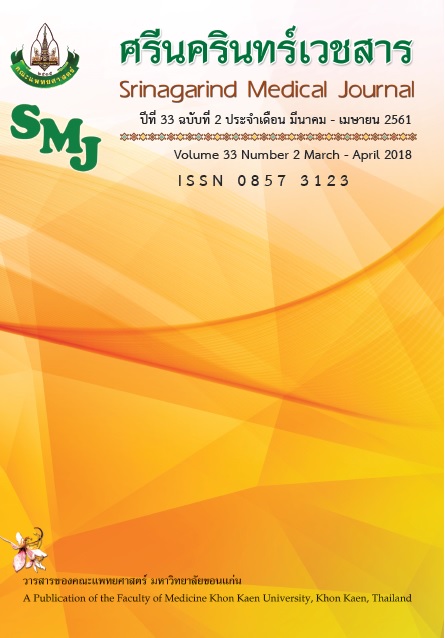Prevalence and Associated factors of I-sarn Syndrome among the Diabetic Patients and Hypertensive Patients in Rural Communities,Public Health Region 7, Thailand
Keywords:
I-sarn syndrome; Type 2 Diabetes; Hypertension; กลุ่มอาการอีสานรวมมิตร; โรคเบาหวาน; โรคความดันโลหิตสูงAbstract
Background and objectives: I-sarn syndrome (ISS) is one of the important health issues that is common among diabetic (T2DM) and hypertensive (HT) patients in the Northeast of Thailand. It has been shown that ISS is related to small renal stones, chronic pyelonephritis and chronic kidney disease. The purposes of this study were to determine the prevalence of ISS and their associated factors among the diabetic and hypertensive patients in rural communities.
Methods: A retrospective cohort study, using patients’ data from Ubonratana hospital’s pilot project in 13 rural sub-districts in public health region 7was conducted. Altogether, 3,332 T2DM and HT patients, aged 20 to 80 years were interviewed during January 2016 - September 2016. Instruments were used as the following: 1) questionnaire for demographic data 2) questionnaire for physical health, health behaviors 3) Laboratory examination: GFR, HbA1C and Urinalysis. Data analysis was conducted by frequency, percentage, prevalence rate with 95% CI, Pearson’s chi square test, odds ratio and multiple logistic regression.
Results: Most of the participants were farmers (77.7%), 29.3% were males, 56.6% were older than 60 years. Age-gender adjusted prevalence of ISS was 32.5% (95%CI: 30.9 - 34.1). The associated factors of ISS were the consumption of bamboo shoot & fermented rice noodle (adjusted OR = 2.1, 95% CI: 1.4-3.1), consumption foods containing monosodium glutamate (MSG) (adjusted OR = 1.9, 95% CI: 1.1-3.3), decreased glomerular filtration rate (GFR) < 60 ml/min/1.73 m2 (adjusted OR = 2.5, 95% CI: 1.6-3.9), albuminuria (adjusted OR = 1.7, 95% CI: 1.1-2.4) and history of urine with sediment (adjusted OR = 2.8, 95% CI: 1.9-4.2)
Conclusion: The study revealed that one third of the T2DM and HT patients had ISS and significantly related to consumption of bamboo shoot & fermented rice, consumption foods containing MSG, decreased GFR, albuminuria and history of urine with sediment.
ความชุกและปัจจัยที่สัมพันธ์กับกลุ่มอาการอีสานรวมมิตรในผู้ป่วยเบาหวานและความดันโลหิตสูงในชุมชน ของเขตสุขภาพที่ 7
อาคม บุญเลิศ, อมร เปรมกมล, ปัตพงษ์ เกษสมบูรณ์
ภาควิชาเวชศาสตร์ชุมชน คณะแพทยศาสตร์ มหาวิทยาลัยขอนแก่น
หลักการและวัตถุประสงค์: กลุ่มอาการอีสานรวมมิตร (อสร.) เป็นหนึ่งในปัญหาด้านสุขภาพที่สำคัญในผู้ป่วยโรคเบาหวานและโรคความดันโลหิตสูงในภาคอีสาน โดยพบว่ากลุ่มอาการดังกล่าวมีความเกี่ยวข้องกับผู้ป่วยที่ตรวจพบนิ่วไตขนาดเล็กผู้ป่วยโรคกรวยไตอักเสบเรื้อรัง และโรคไตเรื้อรัง ผู้วิจัยจึงสนใจศึกษาความชุกและปัจจัยที่สัมพันธ์กับกลุ่มอาการ อสร. ของผู้ป่วยโรคเบาหวานและความดันโลหิตสูงในชุมชน
วิธีการศึกษา: เป็นการศึกษาใช้วิธีรวบรวมข้อมูลที่มีอยู่เดิม (Retrospective cohort study) จากข้อมูลผู้ป่วยในโครงการนำร่องของโรงพยาบาลอุบลรัตน์ 13 ตำบลในเขตสุขภาพที่ 7 คัดเลือกกลุ่มตัวอย่างจากผู้ป่วยโรคเบาหวานและความดันโลหิตสูงอายุ 20-80 ปี ในช่วงเดือนมกราคม – กันยายน พ.ศ.2559 จำนวน 3,332 ราย เครื่องมือที่ใช้คือ 1) แบบบันทึกข้อมูลทั่วไปของผู้ป่วย 2) แบบบันทึกข้อมูลสุขภาพกายและพฤติกรรมสุขภาพ 3) ผลตรวจทางห้องปฏิบัติการ เช่น ค่าอัตราการกรองของไต ค่าน้ำตาลสะสม ผลตรวจปัสสาวะ วิเคราะห์ข้อมูลโดยใช้สถิติเชิงพรรณนา ได้แก่ ความถี่ร้อยละอัตราความชุกร่วมกับช่วงเชื่อมั่นร้อยละ 95เพียรสันไคสแควร์อัตราส่วนออดและการวิเคราะห์การถดถอยพหุโลจิสติกส์
ผลการศึกษา: กลุ่มตัวอย่างส่วนใหญ่เป็นเกษตรกร ร้อยละ 77.7 เป็นเพศหญิงร้อยละ 70.7 เป็นผู้ป่วยอายุ 60 ปีขึ้นไป (ร้อยละ 56.6)โดยความชุกของกลุ่ม อสร. พบร้อยละ32.5 (95% CI: 30.9 – 34.1) ปัจจัยที่มีความสัมพันธ์กับกลุ่มอาการ อสร. อย่างมีนัยสำคัญทางสถิติ คือ การบริโภคหน่อไม้และขนมจีน (adjusted OR = 2.1, 95% CI: 1.4-3.1)การบริโภคอาหารที่ใส่ผงชูรส (adjusted OR = 1.9, 95% CI: 1.1-3.3) การเป็นโรคไตเรื้อรัง โดยที่ค่าอัตราการกรองของไตต่ำกว่า 60 ml/min/1.73 m2 (adjusted OR = 2.5, 95% CI: 1.6-3.9)ภาวะโปรตีนรั่วในปัสสาวะ (adjusted OR = 1.7, 95% CI: 1.1-2.4) และการปัสสาวะมีตะกอน (adjusted OR = 2.8, 95% CI: 1.9-4.2)
สรุป: กลุ่มอาการ อสร.ในผู้ป่วยโรคเบาหวานและความดันโลหิตสูงในชุมชนพบได้มากถึง 1 ใน 3 และกลุ่มอาการดังกล่าวมีความสัมพันธ์อย่างมีนัยสำคัญทางสถิติกับการบริโภคหน่อไม้ ขนมจีน การบริโภคอาหารที่ใส่ผงชูรส การเป็นโรคไตเรื้อรัง ภาวะโปรตีนรั่วในปัสสาวะ และการปัสสาวะมีตะกอน




